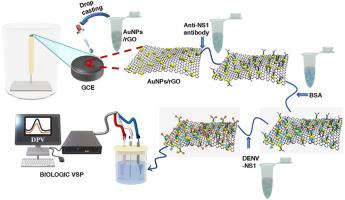Biowaste-derived gold nanoparticles on reduced graphene oxide: An innovative nanoplatform for the label-free immunosensing of dengue NS1
IF 6
2区 化学
Q1 CHEMISTRY, ANALYTICAL
引用次数: 0
Abstract
Background
Dengue virus (DENV) infection poses a considerable risk to human health, especially in tropical and subtropical regions where the probability of Aedes aegypti mosquito proliferation is high. To date, no effective vaccination or antiviral medicine has been available to combat dengue. Traditional detection methods are often complex, costly, time-consuming, and cumbersome. Therefore, there is a crucial need for an alternative detection method that allows for rapid and accurate identification of the DENV-specific non-structural protein 1 (NS1). The present study aims to develop biowaste-mediated gold nanoparticles on reduced graphene oxide (AuNPs/rGO) for the early detection of dengue NS1.
Results
Herein, a label-free electrochemical immunosensing platform based on green-synthesized (using biowaste, i.e., Potato peel extract) AuNPs in combination with rGO was designed and used for early detection of DENV-NS1. These synthesized AuNPs/rGO provide an ideal environment for immobilizing dengue-specific anti-NS1 antibodies. The immunosensor's performance was assessed through electrochemical techniques such as differential pulse voltammetry (DPV), square wave voltammetry (SWV), and electrochemical impedance spectroscopy (EIS). The immunosensor exhibited linearity with the concentrations of DENV-NS1 in 0.01–100 ng mL−1, with the limit of detection (LOD) 1.43 ng mL−1 and 2.40 ng mL−1 in DPV and SWV analyses, respectively. Immunosensor shows remarkable stability and reproducibility, with low relative standard deviation (RSD) values of 3.35 % and 1.43 % for DPV and 1.21 % and 0.90 % SWV, respectively. The immunosensor exhibited selectivity for DENV-NS1 against other interfering species commonly found in blood serum (bovine serum albumin (BSA), glucose, and cysteine) with minimal non-specific binding of 9.09 %, 7.04 %, and 5.64 %, respectively, in DPV analysis. In SWV analysis, the non-specific binding was 7.31 %, 6.18 %, and 5.08 %, respectively. This indicates that immunosensors can offer reliable and accurate outcomes when assessing DENV-NS1 in blood serum samples.
Significance and novelty
This immunosensing platform can be used to circumvent complex sample pretreatment processes and enable early and rapid detection of DENV-NS1. Hence, this method offers a rapid, selective, sensitive, and cost-effective alternative to conventional methods, eliminating the need for toxic chemical reagents.


基于还原氧化石墨烯的生物废物衍生金纳米颗粒:用于登革热NS1无标记免疫传感的创新纳米平台
登革热病毒(DENV)感染对人类健康构成相当大的风险,特别是在埃及伊蚊繁殖可能性高的热带和亚热带地区。迄今为止,没有有效的疫苗接种或抗病毒药物可用于防治登革热。传统的检测方法往往复杂、昂贵、耗时且繁琐。因此,迫切需要一种能够快速准确鉴定denv特异性非结构蛋白1 (NS1)的替代检测方法。本研究旨在开发基于还原氧化石墨烯(AuNPs/rGO)的生物废物介导的金纳米颗粒,用于登革热NS1的早期检测。结果设计了基于绿色合成(利用生物废弃物,即马铃薯皮提取物)AuNPs与氧化石墨烯结合的无标记电化学免疫传感平台,用于DENV-NS1的早期检测。这些合成的AuNPs/rGO为固定化登革热特异性抗ns1抗体提供了理想的环境。通过差分脉冲伏安法(DPV)、方波伏安法(SWV)和电化学阻抗谱(EIS)等电化学技术对免疫传感器的性能进行了评估。DENV-NS1在0.01 ~ 100 ng mL-1范围内呈线性关系,DPV和SWV的检测限分别为1.43 ng mL-1和2.40 ng mL-1。免疫传感器具有良好的稳定性和重复性,DPV和SWV的相对标准偏差(RSD)分别为3.35%和1.43%和1.21%和0.90%。在DPV分析中,DENV-NS1对血清中常见的干扰物质(牛血清白蛋白(BSA)、葡萄糖和半胱氨酸)具有最小的非特异性结合选择性,分别为9.09%、7.04%和5.64%。在SWV分析中,非特异性结合率分别为7.31%、6.18%和5.08%。这表明免疫传感器在评估血清样本中的DENV-NS1时可以提供可靠和准确的结果。该免疫传感平台可用于规避复杂的样品前处理过程,实现DENV-NS1的早期快速检测。因此,该方法提供了一种快速、选择性、敏感性和成本效益高的替代传统方法,消除了对有毒化学试剂的需求。
本文章由计算机程序翻译,如有差异,请以英文原文为准。
求助全文
约1分钟内获得全文
求助全文
来源期刊

Analytica Chimica Acta
化学-分析化学
CiteScore
10.40
自引率
6.50%
发文量
1081
审稿时长
38 days
期刊介绍:
Analytica Chimica Acta has an open access mirror journal Analytica Chimica Acta: X, sharing the same aims and scope, editorial team, submission system and rigorous peer review.
Analytica Chimica Acta provides a forum for the rapid publication of original research, and critical, comprehensive reviews dealing with all aspects of fundamental and applied modern analytical chemistry. The journal welcomes the submission of research papers which report studies concerning the development of new and significant analytical methodologies. In determining the suitability of submitted articles for publication, particular scrutiny will be placed on the degree of novelty and impact of the research and the extent to which it adds to the existing body of knowledge in analytical chemistry.
 求助内容:
求助内容: 应助结果提醒方式:
应助结果提醒方式:


